
Background
It has been almost ten years since CCAT has been painted. The last natural paint project was in 2007: CCAT natural paints and since then some of the walls have faded, cracked and chipped. In spring of 2017, students of Engineering 305: Jonathan, Derek, Tess and Amy will research and develop new natural paint recipes to repaint CCAT.
Problem statement
The objective of this project is to use natural and local materials to repaint CCAT. Through research, development and documentation we will publish our findings and make natural painting more accessible to the general public.
Project Criteria
The following criteria were determined by spending time with the students living at CCAT. This involved asking for their input directly, observing their interactions with their space, and gauging their reactions to certain aspects from the last project or suggestions from our team. The only additional specification was that the paints be made from non-toxic materials, which was inherent to the project.

| Criteria | Constraints | Weight (1-10) |
|---|---|---|
| Rooms | At least the main upstairs. This includes kitchen, dining, living. CCAT Directors are open to us doing the downstairs as well. | |
| Locality | Ingredients must come from within California or closer | |
| Aesthetics | Must be more pleasing to the eye than the 2007 project. | |
| Feeling of "lightness" | The painted rooms must feel lighter than a "cave"-like feeling, as described by one CCAT resident. | |
| Durability | The paints used should hold up longer than the ones used in 2007. We will attempt to test and compare for each binder option. | |
| Cost | We want to see if we can meet the constraint of the paint being cheaper than conventional paints, or at least cheaper than the project paints in 2007, which were more expensive than conventional paints. | |
| Color: hue | Restricted to cool side of color wheel, also exclude purple. | |
| Color: saturation | Restricted to neutral tones rather than vibrant ones. | |
| Color: value | Restricted to the light-grey to white side of the scale. |
Timeline
Tentative timeline for the project. "Week of" entries indicate work will take place on Tu/Th/F/Sa/Su of these weeks, depending on availability of group members. (*)The schedule shown is only one possibility, where paints are made in March and painting is done at the end of March and throughout April. This is subject (and likely) to change, as the clients may prefer us to stagger the painting so that they have more time to prepare, but exact dates are unknown at this time.
| Plan | Done on/by |
|---|---|
| Meet with Lonny, go to Phoenix Ceramic Supply for pigment & clay | 2/14/2017 |
| Meet at CCAT, make flour paint swatches for pretotype | 2/16/2017 |
| Pretotype Turn-in | 2/19/2017 |
| Ingredients for other paints/pigments (donated or bought?) | 2/26/2017 |
| Budget proposal | 2/26/2017 |
| Make 2 more paint types (Tue/Thu/Fri/Weekend) | Week of 3/3/2017 |
| Project design turn-in | 3/5/2017 |
| Making paints/pigments/painting* | Week of 3/10/2017 |
| Making paints/pigments/painting* | Week of 3/17/2017 |
| Making paints/pigments/painting* | Week of 3/24/2017 |
| Natural building lab; paint day | 3/27/2017 |
| Painting/Appropedia page* | Week of 3/31/2017 |
| Painting/Appropedia page* | Week of 4/7/2017 |
| Painting/Appropedia page* | Week of 4/14/2017 |
| Draft Appropedia page | 4/16/2017 |
| Painting/Appropedia page* | Week of 4/21/2017 |
| Cutoff for painting | 4/28/2017 |
| Final Appropedia page | 5/5/2017 |
Cost
At this point in time, we are not officially sure of what rooms are being covered by this project because we have been unable to get a matching confirmation from both CCAT and Lonny. CCAT has expressed that they would like us to paint the upstairs living room, dining room, and kitchen, as well as the downstairs main room. The current budget assumes that these are the rooms being painted.
Our current scope is to perfect the flour and milk paint recipes, based on the experiences of the 2007 group and the amount of area we have to cover. By only using two recipes, we can guarantee that we will have the best versions possible by the time we are ready to paint the walls. With the current number of rooms, this means each recipe will be used twice. We can and will adjust our budget as we test extenders (due to their relative expense) and confirm which rooms will be painted.
Budget
This estimated budget is based on our experience so far with making the flour paint and the 2007 group's budget and experience with the milk paint. The two most uncertain factors are the cost of the whiting chalk and how much milk we will need, because we have not yet made quark and that process gave the 2007 group the most trouble.
Flour Paint
| Quantity | Material | Cost | Estimated # Needed | Total Cost |
|---|---|---|---|---|
| 2 lbs | Flour | $2.00 | 5 | $10.00 |
| 5 lbs | Clay | $2.95 | 4 | $11.80 |
| 0.25 lbs | Pigment | $3.50 | 2 | $7.00 |
| 1.5 lbs | Whiting | $7.00 | 1 | $7.00 |
| Total per room | $36.80 | |||
| Total for project (2 rooms) | $71.60 | |||
Milk Paint
| Quantity | Material | Cost | Estimated # Needed | Total Cost |
|---|---|---|---|---|
| 1 gal | Milk | $3.00 | 10 | $30.00 |
| 5 lbs | Clay | $2.95 | 3 | $8.85 |
| 0.25 lbs | Pigment | $3.50 | 2 | $7.00 |
| 1.5 lbs | Whiting | $7.00 | 1 | $7.00 |
| 2 qts | Vinegar | $2.00 | 1 | $2.00 |
| 1 lbs | Baking Soda | $1.00 | 1 | $1.00 |
| Total per room | $57.85 | |||
| Total for project (2 rooms) | $113.70 | |||
With four rooms, this leaves a estimated total project cost of $185.30
Design
Flour Paint
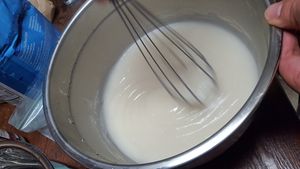

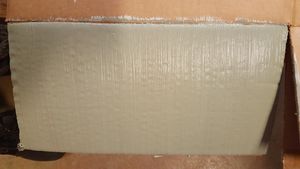
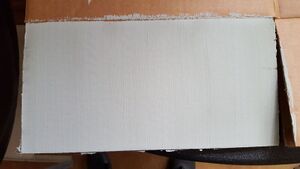
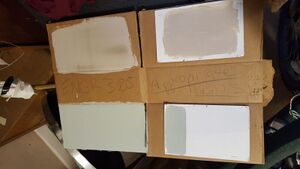
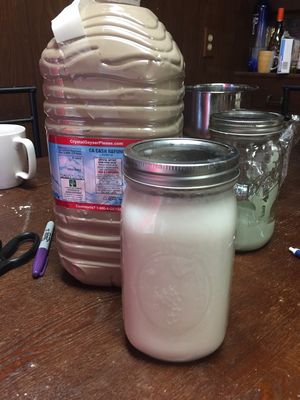
Milk Paint
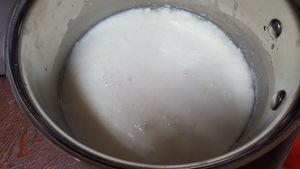
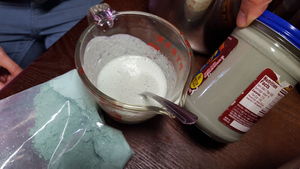
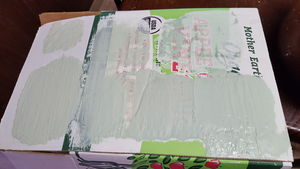
Literature Review
This is a review of the available literature pertinent to the Appropriate Paints Project at CCAT 2017.
Paint Basics
What is paint?
Paint is applied to a surface as a liquid and dries to a solid, called a film. [1] Paint is made from a resin/binder, a pigment, and a solvent/thinner; it can also have an extender or additives. [1] [2] The pigment, usually a powder, gives the paint its color and level of gloss. The binder is a solid that holds the pigment, gives the paint its texture, and makes the paint stick to surfaces. The solvent makes the paint less viscous and easier to spread for application; the solvent and binder together are called the vehicle. [1] An extender is an additional pigment that has larger particles.[1] Extenders help conserve binder and increase the lifespan of the paint film. Additives can be used to modify properties of the paint, e.g. to make it more weather resistant, to reduce drying time, or to make the paint last when stored. [1]
Conventional Paints
Pigments and Binders Used
Binders are the component in household paints that make it have a thicker consistency. If binders were not added, the water component would be too strong to adhere to the wall for instance and just drip to the bottom of said surface. Furthermore, the binder, sometimes referred to as resin, is the ingredient that holds the pigment together in a tough, continuous film, and provides film integrity and adhesion. When the binder is mixed with the solvent, the combination is known as a vehicle. The most widely used binders in paints today are: acrylic polymers, alkyd polymers, epoxy polymers. [3] To give color to paints, pigments are used. Commonly, inorganic pigments such as white titanium dioxide (titanium(IV) oxide) and calcium carbonate are the most frequent to appear in an ingredient list. Other recurring pigments include: iron oxides to give hues of red, yellow, and black, followed by zinc oxide and carbon black.
Environmental Impact
The impacts from conventional paints have historically come from the choice of solvent. Paint can be water-based or solvent-based. Solvent-based paints use an organic solvent such as benzene instead of water. When solvent-based paints are applied, drying, and curing, the solvent evaporates and releases volatile organic compounds (VOCs) to the environment.[2] This is what causes the smell that freshly painted walls often have. About 50 years ago, most paints available on the market were solvent-based, but today, up to 80% of paints available are water-based due to VOC regulations. [4] Even so, solvents are the third highest VOC-emitting industry in the US. [5] In addition to being more environmentally friendly, water-based paints are easier to handle, quicker-drying, and more economic than solvent-based paints. [2] Water’s properties (surface tension, density, and thermal conductivity) make it a better solvent than most organic solvents. [2]
According to the EPA, the concentration of many VOCs is up to ten times higher indoors than outdoors. [6] The agency stresses that while some products may be exempt from VOC regulations because they are safe to use outside, these same products may be health hazards if used inside, and best use practices (e.g. using outdoors or in a well-ventilated area) outlined on product labels should be followed closely. The agency also warns against buying more paint than one needs and storing the excess. [6]
The main impacts of VOCs in the atmosphere are ground-level ozone production, human health effects, and effects on plants. VOCs react with sunlight and gases such as nitrogen oxides and carbon monoxide to form secondary pollutants, such as ozone, which contributes to photochemical smog and the greenhouse effect when generated in the troposphere; tropospheric ozone is also toxic to plants. [2] [6][7] Human symptoms of VOC exposure are nose and throat irritation, eye irritation, headaches, dizziness, nausea, fatigue, and allergic reactions on the skin. [6] Long-term, VOCs can cause damage to the central nervous system, liver, and kidneys. [6] VOC exposure can exacerbate pre-existing conditions, such as asthma. Additionally, certain VOCs are known to cause cancer in animals and humans. [6] Even "low VOC" or "VOC-free" marketed paints consistently emit more VOCs than their labels claim to have in the product. [8]
The relationship between plants and VOCs is complicated, because about 70% of total VOC emissions come from plants (US data.) [5] All plants emit VOCs, and studies suggest that they either have physiological roles in plants or are emitted due to their properties (e.g. their volatility.) [9] VOCs are a very widely defined group, and just because plants produce them does not mean they are always good for plants. High concentrations of VOCs can damage plants. Emissions of different VOC species do different things to plants, for example, ethylene is known to mimic a growth-regulating hormone.[7]
Conventional paint, and many of the products associated with them (e.g. thinners) are classified as household hazardous waste by the EPA and must be disposed of properly. [10]
Many materials are used as pigments in paint, but one of the main sources of pigment is titanium dioxide (TiO2). TiO2 must be processed from ilmenite ore, which means it has inherent environmental impacts, such as ozone layer depletion, land use, ecotoxicity, and the indirect impacts from the mining being powered by fossil fuels. [11]
Finally, a life cycle impact of conventional paints is that multiple components can come from petroleum, such as the binder and mainly the solvent. This means conventional paints directly contribute to greenhouse gas emissions as well as soil, air, and water pollution by virtue of being petroleum products.
Wall Maintenance in Local Climate (Humboldt County, California USA)
Conventional paints within a controlled environment and applied with correct procedure can last up to five years without maintenance. [12] However, there are many real factors that can affect the performance of interior paint making maintenance more frequent and necessary. Humidity is one factor that has a strong effect on interior paint. It can disrupt the function of paint subsequently causing damage to the walls. Exposed to high humidity, interior paints can: alter in color, form deposits, crack, swell, peel and sweat. All of which require a procedure of cleaning and removing of malfunctioning paint, and reapplication of paint with a possible sealer or finish coating.
Appropriate Paints
Pigments and Binders Used
In 2007, the group that did the previous round of appropriate paints at CCAT extensively covered alternative binders; the list has not changed since then, though new recipes exist. The paint options, classified by binder, are flour paint, curdled milk paint, clay paint, egg paint, and oil paint. [13] The binders produce differently textured paints, as documented in 2007: the flour paint is thick and textured, the egg and oil paints are velvety, and their milk paint was slightly glossy and more pastel. [13] However, judging by the results of different recipes found through research, the consistency of the paint can be different even with the same binder. One instance of using an extender or additive in an appropriate paint was found, which was adding lime and clay or chalk to a curdled milk paint to make it more durable. [14]
As for pigments, no photographic evidence was found of successful non-conventional pigments beyond individual claims about certain materials. Some companies claim to sell "natural" or "natural earth" pigments, but there is no definitive information about what the pigments contain on the labels. Creating the pigments for the paints using all natural products can be quite difficult. In the 2007 CCAT painting project the pigments used were created mainly from ground up metal oxides or clay. [13] For example: yellow from ground up iron oxides, green from chrome oxides, and brown from clay. Pigments can be created from a variety of options. Extraction of color pigments from fruits and vegetables is a viable option. One example of this process involves mixing ground of berries with rubbing alcohol and then filtering and evaporating to leave only the pigment. [15]
Wall Maintenance in a Local Climate (Humboldt County, California USA)
Appropriate paints and clay plasters can last a years without maintenance in the right conditions. Often in a home with normal wear and tear, minor damage such as knicks and scratches can expose the wall. In humid climates, it is especially important to maintain the function of appropriate paint and protect the walls from moisture exposure. This entails frequent touch-ups and patching as damage occurs. Yearly reapplication of appropriate paints and plasters is advised. [16]
Paint Recipes
Flour
Flour paste is used as the binder in some appropriate paints. Carole Crews includes this recipe in her book Clay Culture: Plasters, Paints and Preservation.
White Flour Paste using 4 cups flour: Makes almost 6 quarts Tools: quart jar, measuring scoop, whisk, stove, 8 quart pot, plus a smaller bowl or bucket. Heat 1 gallon water in pot on stove. Pour 5 cups cold water into the empty bowl or bucket and add 4 cups of cheap white flour. Whisk in flour until smooth. When water in the pot reaches a rolling boil, whisk in flour mixture. [16] The mix will thicken and look translucent.
This white flour paste is then mixed with clay to bind together the solvent and the pigment. In this recipe Carole adds a few other ingredients for desired look:
Alis Recipe: 6-qt. batch: approx 150 Sq. ft.
Measure one gallon water into bucket. Whisk in: 5 quarts powdered kaolin clay, 2 quarts fine sand and/or whiting, 2 quarts mica (fine flakes or powder), 1 handful of chopped straw (optional), pigment as needed for color (optional), 1 quart cooked flour paste
Mix with a whisk attachment on the end of a cordless power drill. Look for the tacks of the whisk when the mix is thick enough.
Milk
These paints give off a velvety matte look. Recipes call for casein powder mixed with borax as the binder. Casein powder can be purchased or made by curdling milk. [17]
Milk paint recipe with lime added for texture change and increased durability. Includes information about extenders.[14]
Eggs
Egg Tempera Recipe [16]:
First separate yolk from white. Then you can separate the yolk from it's yolk membrane by piercing the yolk and draining the liquid out. Add one teaspoon of water and mix well. Then add this mixture to an equal amount of pigment powder.
Clay
This is a recipe for a fine finish clay plaster that could serve the same function as appropriate paint while also patching cracks or holes that have developed in your wall.
You can separate out clay content from clay-dirt by mixing it well in water and letting it settle for a day. Ladle off the water first and then scoop the very top layer of clay that has separated out from the dirt underneath. Mix 2 parts of this clay with 1/4 part binder of your choice and 3-7 parts of different sized fine sand, whiting or marble dust. [16]
Apply thinly (1/8 in) with a fine plaster trowel, let dry and seal with your choice of sealer.
Other
Urban Finish Plaster Using Paper Pulp [16]:
Soak shredded office paper overnight or longer and beat it to a pulp. Measure out 1 part squeezed out paper pulp, 1/8-1/4 part starch paste, 1 part fine clay, 0-2 parts fine sand.
This can be used to cover over cracks in the wall surface and can be applied directly over sheet rock. This makes for a good primer layer, or adhesion coat, that you can then cover with your choice of appropriate paint.
Hydraulic Lime
This type of paint is suitable for porous surfaces like cement, brick, and stone. It consists of hydraulic lime(a mixture of limestone and clay that is found as a powder) as the binder mixed with water and then mixed with a suitable pigment(alkali resistant). [17]
Oil Paint
Oil-based paints are highly water resistant and can stand up to more cleaning and bumping than other paints. One recipe found uses linseed oil, natural citrus thinner, and powdered chalk.[18]
CCAT
History
In 1978, the Buck House was set to be demolished yet a group of students petitioned to have the house repositioned as an “experiment with appropriate technologies”. With the backing of HSU faculty and the immediate community, the students began work towards re-appropriating the house for the necessary retrofitting and remodeling. In 1980, the CCAT house was ready for move in and over the nearly four decades since, students have learned much from continuing towards making CCAT *** net zero something or other**** someone help me finish that off please.
Purpose
Many commercial paints include chemicals that contribute to indoor air pollution [19]. While many consumers are turning to less pollution causing alternatives, there are still strides that need to be made to reduce the number of greenhouse gas emissions caused by industrial paints. Some retail stores have begun to sell milk paints but many on the market contain more ingredients than if you were to make the paint yourself. Because companies aren’t required to label ingredients used in their paints[20], we will be making our paints from scratch.
Client Criteria
The Rooms
The second floor of the CCAT building which is also the living space for the three co-directors including Austin Anderson whom will be the only returning co-director for the following year. The living room, dining room, kitchen, and hallway will be the subjected rooms.
The Process of Application
For the kitchen and dining room, which are painted a vibrant yellow and red color respectively, a primer will be used to first to achieve the desired outcome of softer colors. Once primer is finished, we will begin the process of adhering the appropriate paints to said walls. For the living room, which is already a softer color, we will directly apply new coat of paint.
The Colors Wanted
Mr. Anderson, stated that he was happy with the way the previous paints had held up through the years but expressed his desire for lighter colors to help make better use of daylight. Currently the kitchen is a bright yellow, living room has one wall greenish brown while other living room walls are light lavender almost tan color, and the dining room is a darker red. Per request of client, we will aim to go for lighter colors and try to stay away from yellow.
References
- ↑ 1.0 1.1 1.2 1.3 1.4 "Paints." The Essential Chemical Industry. March 18, 2013. Accessed January 31, 2017. http://www.essentialchemicalindustry.org/materials-and-applications/paints.html.
- ↑ 2.0 2.1 2.2 2.3 2.4 Sarrica, Stephanie M. Paints: Types, Components and Applications. New York: Nova Science Publishers, 2011.
- ↑ (http://www.essentialchemicalindustry.org/materials-and-applications/paints.html)
- ↑ "Water based vs Solvent based Paints." Paint Quality Institute. 2015. Accessed January 31, 2017. http://www.paintquality.com/en/understanding-paint/water-based-vs-solvent-based.
- ↑ 5.0 5.1 "National Summary of VOC Emissions." EPA. May 24, 2016. Accessed February 01, 2017. https://www3.epa.gov/cgi-bin/broker?polchoice=VOC&_debug=0&_service=data&_program=dataprog.national_1.sas.
- ↑ 6.0 6.1 6.2 6.3 6.4 6.5 "Volatile Organic Compounds' Impact on Indoor Air Quality." EPA. December 05, 2016. Accessed January 31, 2017. https://www.epa.gov/indoor-air-quality-iaq/volatile-organic-compounds-impact-indoor-air-quality.
- ↑ 7.0 7.1 Hester, R. E., and Roy M. Harrison. Volatile Organic Compounds in the Atmosphere. Cambridge: Royal Society of Chemistry, 1995.
- ↑ "Even 'VOC-free' paint can release contaminants." Air Quality Sciences Inc.'s AirfAQS Newsletter, November 2003. Compilation of findings from various measurements of "low VOC" or "VOC free" paint. Summarizes EPA studies and has a table of measurements by Air Quality Sciences Inc.
- ↑ Penuelas, J., and J. Llusia. "Plant VOC emissions: making use of the unavoidable." Trends in Ecology & Evolution 19, no. 8 (2004): 402-04. doi:10.1016/j.tree.2004.06.002.
- ↑ "Household Hazardous Waste (HHW)." EPA. December 28, 2016. Accessed January 31, 2017. https://www.epa.gov/hw/household-hazardous-waste-hhw.
- ↑ Grubb, Geoffrey F., and Bhavik R. Bakshi. "Life Cycle of Titanium Dioxide Nanoparticle Production." Journal of Industrial Ecology 15, no. 1 (2010): 81-95. Accessed January 31, 2017. doi:10.1111/j.1530-9290.2010.00292.x.
- ↑ Sampaio, Alcínia Z., and Daniel P. Rosário. "Maintenance of painted interior walls supported on virtual environments." Journal of Civil Engineering and Construction Technology 3(8) (September 2012): 212-21. Accessed January 30, 2017. http://www.academicjournals.org/JCECT.
- ↑ 13.0 13.1 13.2 Anderson, Jill, and Andrea Lanctot. "CCAT natural paints." Appropedia: The sustainability wiki. October 21, 2016. Accessed January 31, 2017. http://www.appropedia.org/CCAT_natural_paints.
- ↑ 14.0 14.1 "Milk Paint with Lime." Earth Pigments. Accessed January 31, 2017. http://www.earthpigments.com/milk-paint-with-lime/.
- ↑ Blatti, Jillian. 2016. Colorful and Creative Chemistry: Making Simple Sustainable Paints with Natural Pigments and Binders. Journal of Chemical Education.
- ↑ 16.0 16.1 16.2 16.3 16.4 Crews, Carole. Clay Culture: Plasters, Paints and Preservation. Vermont: Gourmet Adobe Press, 2010
- ↑ 17.0 17.1 Edwards, Lynn, and Julia Lawless. The natural paint book. London: Kyle Cathie, 2002. https://books.google.com/books?id=rwkprjb5r3oC&pg=RA1-PT28&lpg=RA1-PT28&dq=egg+based+natural+paint+recipes&source=bl&ots=r1DPEtODB1&sig=GwuNkuOuvFMRbPl2HW1a94aJNkw&hl=en&sa=X&ved=0ahUKEwiI04OGi-7RAhUJ0mMKHVtBCzw4FBDoAQgfMAE#v=onepage&q=egg%20based%20natural%20paint%20recipes&f=false
- ↑ "The Secrets Of Homemade Paint." Off The Grid News. December 2012. Accessed February 01, 2017. http://www.offthegridnews.com/how-to-2/the-secrets-of-homemade-paint/.
- ↑ Baker-Laporte, Paula, Erica Elliott, and John Banta. Prescriptions For A Healthy House. Gabriola Island, B.C.: New Society Publishers, 2008. Print.
- ↑ Curtland, Chris. 2012. "Make Sure the make-Up of Your Paint is Green." Buildings 106 (8): 32. http://ezproxy.humboldt.edu/login?url=http://search.proquest.com/docview/1037052677?accountid=11532.